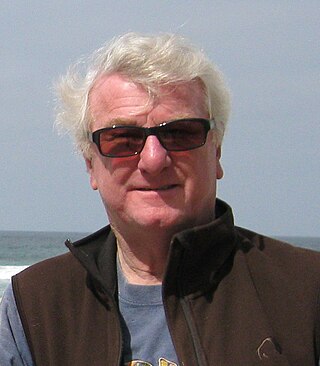
The Art Gallery of Ontario is an art museum in Toronto, Ontario, Canada, located in the Grange Park neighbourhood of downtown Toronto, on Dundas Street West. The building complex takes up 45,000 square metres (480,000 sq ft) of physical space, making it one of the largest art museums in North America and the second-largest art museum in Toronto, after the Royal Ontario Museum. In addition to exhibition spaces, the museum also houses an artist-in-residence office and studio, dining facilities, event spaces, gift shop, library and archives, theatre and lecture hall, research centre, and a workshop.
Pierre Huyghe is a French artist who works in a variety of media from films and sculptures to public interventions and living systems.

Walter Joseph Phillips was an English-born Canadian painter and printmaker. He is credited with popularizing the colour woodcut in the style of the Japanese, in Canada.

Joseph Thomas Del Pesco is a contemporary art curator and arts writer. He is currently the International Director of Kadist.
Mark Leckey is a British contemporary artist. His found object art and video pieces, which incorporate themes of nostalgia and anxiety, and draw on elements of pop culture, span several works and exhibitions. In particular, he is known for Fiorucci Made Me Hardcore (1999) and Industrial Light and Magic (2008), for which he won the 2008 Turner Prize.
Tony Tasset is an American artist. His works consists mainly of video, bronze, wax, sculpture, photography, film, and taxidermy. He has had exhibitions in Dallas, Chicago, Milwaukee, New York, Los Angeles, Germany, Canada, Portugal, Italy, Ecuador, and London.

Ragnar Kjartansson is a contemporary Icelandic artist who engages multiple artistic mediums throughout his performative practice. His video installations, performances, drawings, and paintings incorporate the history of film, music, visual culture, and literature. His works are connected through their pathos and humor, with each deeply influenced by the comedy and tragedy of classical theater. Ragnar's use of durational, repetitive performance to harness collective emotion is a hallmark of his practice and recurs throughout his work.
Shary Boyle D.F.A. is a contemporary Canadian visual artist working in the mediums of sculpture, drawing, painting and performance art. She lives and works in Toronto.
Ron Terada is a Vancouver-based artist working in various media, including painting, photography, video, sound, books, and graphic design.
Paulette Phillips is a Canadian artist based in Toronto. She was born in Halifax, Nova Scotia. Her conceptually oriented art practice combines film and video installation, sculpture, photography and performance. Phillips is a professor at Ontario College of Art & Design University where she has taught studio practice in film, installation and performance since 1986. A graduate of York University (2008) and the Canadian Film Centre (1992), Phillips became a certified polygraph examiner after completing a course at the Maryland Institute for Criminal Justice (2009). Phillips is represented by Diaz Contemporary (Toronto) and Danielle Arnaud Contemporary Art (London).
Andrea Büttner is a German artist. She works in a variety of media including woodcuts, reverse glass paintings, sculpture, video, and performance. She creates connections between art history and social or ethical issues, with a particular interest in notions of poverty, shame, vulnerability and dignity, and the belief systems that underpin them.
Mina Forsyth was a Canadian artist. She is known for her expressionist and abstract landscapes, figural works and still life paintings.

Malcolm Collett is a Canadian animator.

Allyson Clay is a Canadian visual artist, curator, and educator based in Vancouver, B.C.
Nancy Tousley is a senior art critic, journalist, art writer and independent curator whose practice has included writing for a major daily newspaper, art magazines, and exhibition catalogues.
Brittney Bear Hat is a half Blackfoot, half Cree artist. She makes work in a variety of media, including photography, installation and video, as a means to explore how memory and personal identity construct her Native identity.
Richelle Bear Hat is a Blackfoot and Cree artist, based in Calgary, Alberta, Canada, on Treaty 7 territory. Bear Hat's work explores the ancestral transmission of knowledge, memory, and Indigenous relationships to land. According to curator Kristy Trinier, "her practice investigates ideas surrounding family relationships and the types of knowledge that are capable of being passed through them. These ideas are explored through the use of photography, transfers, video and paper based works. It is important to use materials and means of production that support the transference of memory and provide a platform for storytelling."
Âhasiw Maskêgon-Iskwêw (1958–2006) was a Cree and French Métis theorist, curator and artist. Maskêgon-Iskwêw was a significant figure in the field of contemporary Indigenous arts, and a formative proponent of digital media within Indigenous communities. In their 2015 book dedication to him, Steven Loft and Kerry Swanson describe Maskêgon-Iskwêw as "one of the foremost thinkers and practitioners of Aboriginal new media art."
Ronald Benjamin Moppett is a Canadian painter. He is known primarily for abstract paintings and for works in which he combines paint and collage, along with non-traditional materials. Moppett is based in Calgary, Alberta.
Laura Millard is a Canadian contemporary artist. She uses for her installations drawings and videos records of the marks left on the earth obtained from drones, such as traces of the tracks of skates and snowmobiles on ice in northern Canada in a long-term investigation of ways to reinvent the landscape tradition of Canada. She also is an educator with over many years of experience working at OCAD University and a writer; she lives and works in Toronto.







